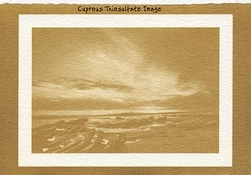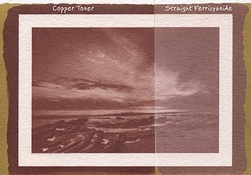nmp
Member
I inadvertently discovered that my 2% K ferricyanide solution that I have been re-using as a toner for cuprotypes contained ferrocyanide as well. Then it dawned on me, of course ferrocyanide is a by product of the reduction of ferricyanide. For example, in case of blue toning of silver gelatin, ferricyanide bleaches (oxidizes) silver, forming silver ferrocyanide and potassium ferrocyanide. The latter forms Prussian blue promptly with ferric ammonium citrate that is present in the toner. In that case, the silver ferrocyanide may be fixed out (via bromination) or be redeveloped or sulfide-toned to end up with additive toning rather than replacement toning – boosting the density of the print and also shifting the color to green.
In the case of cuprotypes, ferrocyanide toning is based on the same principle but follows a slightly different path. Here, copper(i) is oxidized to copper(ii) and copper(ii) combines with ferrocyanide, the now reduced form of ferricyanide, to make Hatchett’s brown. Potassium ferrocyanide is also a by-product. However, unlike blue toning, it simply goes into the solution, accumulating in the toner. So what if we were able to capture this ferrocyanide and get it to make more copper ferrocyanide? By my chemical balancing, for every 4 ferricyanide and 4 Cu(i), we get 1 copper ferrocyanide and 2 potassium ferrocyanide molecules.
4K3Fe(CN)6 + 4Cu+1 → Cu4[Fe(CN)6]2 (s) + 4K+ + 2K4Fe(CN)6
So if we add CuSO4 to the toner:
2K4Fe(CN)6 + 4CuSO4 → Cu4[Fe(CN)6]2 (s) – another molecule of Hatchett’s Brown.
Of course, CuSO4 will form cupric ferricyanide instantly in the toner – a kind of muddy brown compound. So we borrow the technique used in copper toning of silver gelatin – using a citrate to bind up the copper so it can co-exist with ferricyanide. I found the typical copper toner (like the one from Photographer’s Formulary) too slow for cuprotypes (more so if it was to be brush or rod-coated which I prefer) so I modified it to a more concentrated single-use version.
Next the recipe and pictures.
:Niranjan.
In the case of cuprotypes, ferrocyanide toning is based on the same principle but follows a slightly different path. Here, copper(i) is oxidized to copper(ii) and copper(ii) combines with ferrocyanide, the now reduced form of ferricyanide, to make Hatchett’s brown. Potassium ferrocyanide is also a by-product. However, unlike blue toning, it simply goes into the solution, accumulating in the toner. So what if we were able to capture this ferrocyanide and get it to make more copper ferrocyanide? By my chemical balancing, for every 4 ferricyanide and 4 Cu(i), we get 1 copper ferrocyanide and 2 potassium ferrocyanide molecules.
4K3Fe(CN)6 + 4Cu+1 → Cu4[Fe(CN)6]2 (s) + 4K+ + 2K4Fe(CN)6
So if we add CuSO4 to the toner:
2K4Fe(CN)6 + 4CuSO4 → Cu4[Fe(CN)6]2 (s) – another molecule of Hatchett’s Brown.
Of course, CuSO4 will form cupric ferricyanide instantly in the toner – a kind of muddy brown compound. So we borrow the technique used in copper toning of silver gelatin – using a citrate to bind up the copper so it can co-exist with ferricyanide. I found the typical copper toner (like the one from Photographer’s Formulary) too slow for cuprotypes (more so if it was to be brush or rod-coated which I prefer) so I modified it to a more concentrated single-use version.
Next the recipe and pictures.
:Niranjan.









